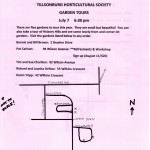It’s Still Just Dirt – July 2015, The Tillsonburg News
by Penny Esseltine
David Ross says there aren’t many gardens that don’t have a lily or two, but he himself has quite a load. In fact this summer he says he probably has about 60 different varieties in his Straffordville garden. Lily season is almost at its peak. Lilies are tall stately plants that carry a number of large, trumpet shaped blooms on each flowering stem. Each stem can be anywhere from two feet to six feet high. Some are lilies (Lilium) but more are daylilies (Hemerocallis). You can tell the difference because lilies have leaves coming up the stem about every two inches whereas the leaves of daylilies sprout from the clump.
Most people are familiar with the orange daylily that grows along roadsides for a few weeks each year. David says they’re “indestructible and very showy.” Some people call them ditch lilies but like David, I have some growing in my backyard. In fact they have been growing back there, hiding the composters, for decades. They never fail, have been blooming for three weeks now, and still look lovely.
Hemerocallis is a Greek word meaning beautiful for a day. Each daylily blossom lasts only one day but each stem bears many buds.
David says daylilies are a good choice for our area with our wide swings in temperature. There are many hybrids derived from several different species which bloom at different times from late June well into September. Thus plants are grouped as early, mid, or late blooming and this can give your garden colour all season long.
Colours range from purple, bright red, pink, lavender and peach to orange, gold, and yellow. There are bicolored flowers, fragrant ones, and double ones, as well as huge meaty ones. David says he can’t honestly say he has a favourite among the daylilies in his garden. “Every one brings colour to the party.”
“If you’re not a green thumb,” David says, “try a clump or two of daylilies. You’ll be pleasantly surprised.” Daylilies prefer a sunny position with a little dappled shade during part of the day. When planting a clump of daylilies dig a hole about 18 inches wide and six to eight inches deep. David recommends using triple mix blended with the local soil and add a good pinch of bone meal too to help with starting root growth. Then water the plant in well. “Keep a good eye on the watering,” David says and he recommends using either a slow release pellet fertilizer, or Miracle Grow every three to four weeks. Dividing clumps every four to five years helps to refresh blooming.
David says we should talk too about the true lily (Lilium) species. They come in different categories including Orientals, Asiatics, Tigers and Easter lilies. David says this group is being attacked by the lily beetle which is bright red and about 1/4 inch long. “The lily beetle can easily defoliate a plant in just a few days. It has no natural predators and seems impervious to most treatments. One sure way to get rid of lily beetles is by hand squishing them,” David says. “So be vigilant and inspect plants daily.”
“Fortunately the daylily is not on this pest’s menu,” David says, “so we are free to enjoy the great mix of daylily colours available.”
Because they are so popular, there is lots of information on lily topics on a number of websites David says. He recommends the Ontario Daylily Society and you can visit them at www.ontariodaylily.on.ca.
For information about the Tillsonburg Horticultural Society visit tillsonburghorticultural.ca.


